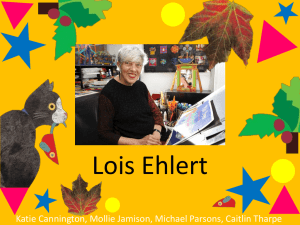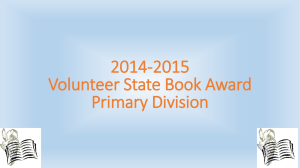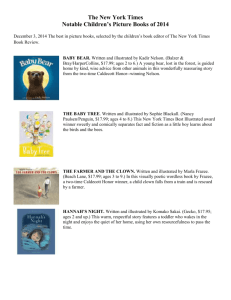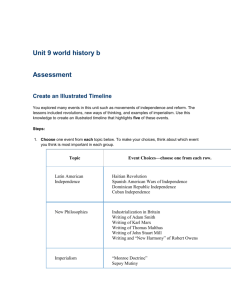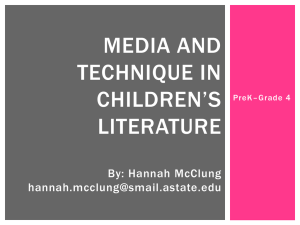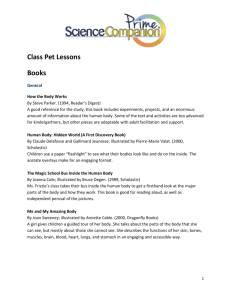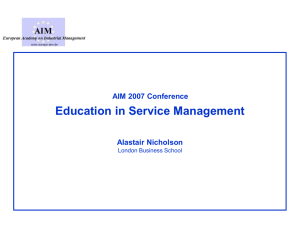Level1andLevel2PosterVerbs
advertisement
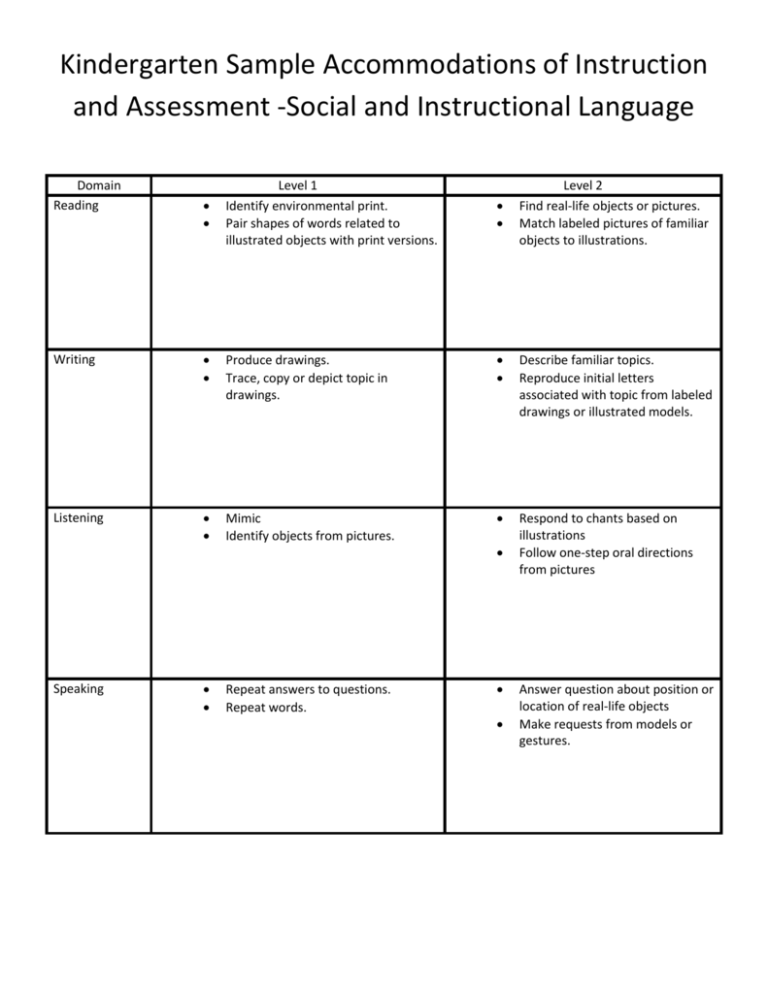
Kindergarten Sample Accommodations of Instruction and Assessment -Social and Instructional Language Domain Reading Level 1 Identify environmental print. Pair shapes of words related to illustrated objects with print versions. Level 2 Find real-life objects or pictures. Match labeled pictures of familiar objects to illustrations. Writing Produce drawings. Trace, copy or depict topic in drawings. Describe familiar topics. Reproduce initial letters associated with topic from labeled drawings or illustrated models. Listening Mimic Identify objects from pictures. Respond to chants based on illustrations Follow one-step oral directions from pictures Repeat answers to questions. Repeat words. Speaking Answer question about position or location of real-life objects Make requests from models or gestures. Kindergarten Sample Accommodations of Instruction and Assessment -The Language of Language Arts Domain Listening Level 1 - Entering Point to features of big books in a large group according to oral commands. Level 2 -Emerging Show directionality of print in various sources in a large group according to oral commands Repeat key words from picture cues. Repeat words or phrases supported by illustrations Reading Match pictures and icons with a partner Distinguish between illustrated examples of print and non-print Sort pictures and icons with a partner Match illustrated examples of the same form of print Writing Experiment making symbols or letters from models using realia Draw or trace examples of environmental print. Reproduce symbols or letters from models using realia. Copy examples of environmental print from labeled icons or objects. Speaking Chant phrases or short sentences using gestures from picture cues. Complete phrases from rhymes supported by illustrated models Kindergarten Sample Accommodations of Instruction and Assessment -The Language of Mathematics Domain Listening Speaking Reading Writing Level 1 - Entering Associate size of real-life objects with non-standard measurement tools Imitate pattern sounds with physical movement from modeling Participate in and supply words in songs and chants in a whole group. Indicate size of objects in pictures using gestures and words. Identify icons or pictures of real-life objects as modeled Match pictures of real-life objects with figures of geometric shapes. Draw or trace matched pairs of real-life objects as modeled and directed orally 2. Draw, trace or copy pictures from models to express times of day Level 2 -Emerging Sort real-life objects by size using nonstandard measurement. Select “What comes first, next or last?” in illustrated topics according to oral directions. Complete phrases in songs and chants in a whole group Specify size of objects in pictures. Classify icons or pictures of real-life objects that belong and don’t belong to a group as modeled. Classify pictures of real-life objects according to geometric shapes. Connect 1:1 matched sets of real-life objects or pictures as modeled and directed orally Depict times of day from illustrated scenes and models using icons, letters or scribble writings. Kindergarten Sample Accommodations of Instruction and Assessment -The Language of Science Domain Listening Speaking Reading Writing Level 1 - Entering Indicate change in self through gestures or environment from pictures, according to oral commands Classify living or non-living things from oral statements and pictures. Associate senses with physical actions with a partner in L1 or L2 Name familiar objects in photographs or illustrations associated with topic Match outlines of animals to pictures or objects with a partner Apply concepts of print to books about topic Create messages in L1 or L2 Produce drawings of materials needed for scientific inquiry from labeled pictures Level 2 -Emerging Match pictures or photographs of offspring with adults following oral models as examples of change. Match oral descriptions of living or non-living things with pictures. Give examples of uses of senses with a partners in L1 or L2. Describe topic from photographs or illustrations Match pictures of animals with labels to animal icons with a partner Pair labeled pictures to matching icons Practice making letters or scribble writings from models in L1 or L2 using a variety of media Copy names of materials needed for scientific inquiry from labeled pictures Kindergarten Sample Accommodations of Instruction and Assessment -The Language of Social Studies Domain Listening Speaking Reading Writing Level 1- Entering Point to or locate symbols or holiday scenes in classrooms, pictures or objects named orally Associate sounds of different modes of transportation with pictures. Repeat names of and identify objects when modeled in L1 or L2 Repeat names of topics from models and illustrations Categorize pictures according to names in a whole group Recognize related symbols or icons in illustrations Draw self-portrait and copy or trace name Draw personal responses to people, places or object in school from pictures or models. Level 2 -Emerging Show symbols of holidays from pictures or objects based on oral commands Identify modes of transportation from visually supported rhymes or chants Brainstorm names of objects with peers in L1 or L2 Match topic in illustrated scenes using phrases or chunks of language Find labeled illustrations or photographs modeled on word walls or displays in small groups. Match labeled pictures with words about topic from various sources Draw family portrait from models or photographs and identify people by initials Represent people, places or objects in school from pictures and models using letters or scribble writings Grades 1-2 Sample Accommodations of Instruction and Assessment -Social and Instructional Language Domain Reading Writing Listening Speaking Level 1 Follow oral directions according to simple commands using manipulatives or real-life objects Identify symbols, objects or people associated to topic from pictures and oral statements Answer yes/no or choice questions with a partner in L1 or L2 Name objects depicted visually in real-life contexts Match icons or pictures to same on board games with a partner Match illustrated words with a word bank Draw or orally dictate personal experience in L1 or L2 from pictures or photographs Trace, copy or produce words about topic using models and pictures Level 2 Follow oral directions according to complex commands using manipulatives or real –life objects Locate areas from pictures and oral descriptive phrases Share ideas or feelings with a partner in L1 or L2 Tell primary function or use of objects depicted visually Place labeled pictures with corresponding pictures with a partner Identify illustrated phrases Label personal experiences in L1 or L2 using pictures or photographs Make lists for topics using models and pictures Grades 1-2 Sample Accommodations of Instruction and Assessment - Language of Language Arts Domain Listening Speaking Reading Writing Level 1 Identify characters, places or objects from visuals and oral phrases in illustrated pattern or predictable books after numerous reads Follow along with classmates in role play activities modeled and described orally Match pictures to sentences read aloud Name people or objects depicted on illustrated covers of fictional stories with a partner in L1 or L2 Repeat new language related to story pictures or wordless picture books modeled by teachers Name persons (characters) or settings of stories from picture books Pair illustrated features or photographs of places or objects with icons in non-fiction books in small groups Demonstrate awareness of unique sounds by point or through gestures Sequence a series of pictures to tell stories Recognize sounds in spoken words with accompanying illustrations Copy words related to settings or characters in illustrated text from word walls or big books Reproduce symbols, letters or pictures of rhyming pairs from illustrated charts or displays with a partner Select and copy words related to setting or characters in illustrated text from word banks Reproduce illustrated word pairs by families Level 2 Match visuals of characters, places or objects with oral statements from illustrated patterned or predictable books after numerous reads Role play familiar, everyday activities modeled in illustrated books read by teachers in small groups Order pictures of related sentences read aloud that use sequential language Describe people or objects in titles and illustrated covers of fictional stories with a partner in L1 or L2 Describe people or places depicted in story pictures or wordless picture books in small groups or pairs Describe people or objects in titles and illustrated covers of fictional stories Connect illustrated features or photographs or places or objects with descriptive words or phrases in nonfiction books in small groups Match voice to print by pointing to icons, letters or illustrated words Match a series of pictures that tell stories with sequence words Blend sounds together to make words, shown visually Describe setting or characters in illustrated test from phrase walls or big books Pair rhyming words from illustrated charts or displays with a partner Describe settings or characters in illustrated text from phrase banks General list of word families from illustrated models Grades 1-2 Sample Accommodations of Instruction and Assessment - Language of Mathematics Domain Listening Speaking Reading Writing Level 1 Shade or color graphs according to oral commands modeled by a teacher Identify two- or three- dimensional shapes depicted in illustrations described orally Provide identifying information that involves real-world numbers to a partner Recite math-related words or phrases related to basic operations from pictures of everyday objects and oral statements Use diagrams to guide use of standard or metric measurement tools with a partner Match labeled pictures with general words related to topics to pictures Produce pictures with numerals or reproduce words associated with quantities from models Find and reproduce number words from an assortment of labeled visuals Level 2 Identify data in graphs from oral commands or questions modeled by a teacher Match attributes of two- or threedimensional shapes described orally to objects Give examples of things with realworld number to a partner Restate or paraphrase basic operations from oral statements, referring to pictures of everyday objects Use labeled diagrams from texts to guide use of standard or metric measurement tools with a partner Match words or phrases related to topic to illustrated word banks Take dictation or make notes of examples of phrases associated with quantities in everyday situations Distinguish number words from other math words using graphic or visual support and word banks Grades 1-2 Sample Accommodations of Instruction and Assessment - Language of Science Domain Listening Speaking Reading Writing Level 1 Explore movement or real-life objects by following oral commands and modeling Identify objects according to chemical or physical properties from pictures and oral statements Name objects of the earth or sky from observations or models Use words or phrases related to topic from pictures or photographs Select labeled topic to make posters from magazine pictures with a partner Identify topic from labeled diagrams, pictures in graphs or charts Label objects that represent topics from real-life or illustrated examples in L1 or L2 Note difference or change by labeling drawings or copying words from word banks Level 2 Move real-life objects by following multi-step oral directions Match objects according to chemical or physical properties from pictures and oral descriptions Describe objects of the earth or sky from observations, photographs or models Make statements about topic from pictures or photographs Search for words and pictures in big books or illustrated trade books associated with topic with a partner Sort topic according to descriptions of their attributes using pictures and phrases with graphic organizers List examples of topics from illustrated word/phrase banks using graphic organizers in L1 or L2 Identify change according to stages of process or cycles using words or phrases Grades 1-2 Sample Accommodations of Instruction and Assessment - Language of Social Studies Domain Listening Speaking Reading Writing Level 1 Match signs around neighborhoods with actions based on oral commands and pictures, realia or field trips with a partner Match topic with illustrated scenes based on oral questions or directions State what families do based on gestures or modeling in small groups Name community workers shown doing their jobs in pictures or illustrated scenes Use phonetic clues to sort or match real or visuals of currencies from around the world Match labeled pictures with illustrated topics Draw and label pictures of different types of home or habitats from models Reproduce or label pictures of topics from illustrated word banks Level 2 Identify signs or places in communities from oral statements and pictures, realia or field trips with a partner Identify characteristics of topic from oral descriptions and visuals Share personal responsibilities within a family based on pictures or role playing in small groups State roles of community workers in pictures or illustrated scenes Associate words or phrases related to currencies with illustrated word/phrase walls or picture books Sort topics described in illustrated phrases Identify different types of homes or habitats from pictures or models using general vocabulary Describe topics from illustrated examples Grades 3-5 Sample Accommodations of Instruction and Assessment - Social and Instructional Language Domain Listening Speaking Reading Writing Level 1 Identify materials needed to complete tasks from realia and oral commands and check with a partner Follow one-step oral commands supported visually or modeled Seek assistance from peers or teachers to gather information in L1 or L2 Produce words in response to WHquestions about topic from picture prompts and models Identify words or phrases related to self or personal experiences from illustrated text or work/phrase walls Select general themes related to topic from pictures and words or phrases Draw, label or list substances or objects around school, home or community related to health or safety from visuals in L1 or L2 Produce words/phrases associated with topic from illustrated scenes and models Level 2 Select materials or resources needed to complete tasks based on realia and compound sentences and check with a partner Follow two-step oral commands supported visually that involve language of request Respond to questions from peers or teachers about information gathering in L1 or L2 Produce phrases or short sentences in response to openended questions from picture prompts Make predications from illustrated text using prior knowledge or personal experiences Locate information in visually or graphically supported text on topic Describe topic from visuals in L1 or L2 List dos and don’ts regarding topic from illustrated scenes Grades 3-5 Sample Accommodations of Instruction and Assessment - Language of Language Arts Domain Listening Speaking Reading Writing Level 1 Match pictures to individual clues based on oral statements with a partner Point to letter combinations, words, parts of books or illustrations in response to teachers’ reading of illustrated books to show comprehension Match pictures to individual clues based on oral statements Match oral statements from narrative or expository material to their illustrated representations Answer WH- or choice questions about pictures of imaginary people, objects or situations from peers in L1 or L2 Describe self with words and gestures Name story elements of various genres depicted visually Find identifying information on biographies from words or phrases in illustrated books or word/phrase walls using physical activity Match labels or identify facts from illustrations and phrases Use cues for sounding out unfamiliar words with accompanying visuals Find identifying information illustrative of main ideas from illustrations, words, or phrases Respond to illustrated events using words or phrases based on models Produce personal word/phrase lists from labeled pictures and check with a partner for edits and revision Identify basic conventions or mechanics in text Level 2 Identify pictures associated with solutions to short mysteries read aloud with a partner Gesture during shared reading of illustrated stories or trade books to show comprehension Determine literal meanings of oral passages from narrative or expository material and match to illustrations Describe pictures of imaginary people, objects or situations to peers in L1 or L2 Compare self with familiar persons using photographs, pictures or graphic organizers Describe story elements of various genres supported by illustrations Sequence events in biographical sketches in illustrated books using graphic organizers or physical activity Identify language associated with fact in fiction or non-fiction illustrated paragraphs Match visually supported context cues with statements to find meaning and facilitate fluency Sort main ideas and details from sentences using visual support and graphic organizers List illustrated events using phrases or short sentences based on models Create phrases/short sentences from models and check with a partner for edits and revision Differentiate uses of conventions or mechanics in illustrated sentences Grades 3-5 Sample Accommodations of Instruction and Assessment - Language of Mathematics Domain Listening Speaking Reading Writing Level 1 Match prices to goods using visually supported materials and oral questions with a partner Mark position/location of numbers of illustrated objects from oral commands Repeat information about math operations using realia or manipulatives and teacher models in L1 or L2 State words in figures or formulas from illustrated examples Recreate drawings from diagrams and written directions in a small group Identify large whole numbers from pictures and models Label fractional parts of diagrams or realia from number word banks Reproduce names of threedimensional shapes from labeled models Level 2 Compare prices of goods using visually supported materials and oral questions with a partner Identify comparative quantities of numbers or illustrated objects from oral commands or questions Paraphrase information about math operations using realia or manipulatives and teacher models in L1 or L2 Use general vocabulary in math sentences from illustrated examples Create scale drawings from diagrams or models and written directions in a small group Identify large whole numbers from pictures or models and phrases or short sentences Describe what the fractional parts mean from diagrams or realia in phrases or short sentences Make lists of real-world examples of three-dimensional shapes from labeled models Grades 3-5 Sample Accommodations of Instruction and Assessment - Language of Science Domain Listening Speaking Reading Writing Level 1 Choose topic from realia, magazines or newspapers following oral directions Identify examples of states of matter from oral statements with visual support Organize and identify natural phenomena from real-life examples in small groups Answer questions that name basic parts of systems depicted visually and modeled Sort real-life objects according to labels Match labeled pictures representing earth materials with vocabulary Label features of the Earth based on diagrams or models Copy names of astronomical objects associated with the solar system from labeled diagrams Level 2 Classify foods from realia, magazines or newspapers following oral directions Distinguish among examples of states of matter from oral statements and visuals support Describe natural phenomena from real-life examples using general vocabulary in small groups Classify or give examples of parts of systems depicted visually Identify ways to conserve from pictures and written text Sort descriptive phrases according to pictures of earth materials Classify features of the Earth, past or present, from diagrams or graphic organizers using phrases or short sentences Describe features of astronomical objects from labeled diagrams Grades 3-5 Sample Accommodations of Instruction and Assessment - Language of Social Studies Domain Listening Speaking Reading Writing Level 1 Identify topic from pictures and oral statements in small groups Identify information on routes from oral statements supported graphically or visually Level 2 Identify topic from pictures and detailed oral descriptions in small groups Arrange information on routes from oral directions supported visually or graphically Locate and show places on maps or globes in L1 or L2 with a partner Provide information about topic depicted in illustrated scenes Trace routes on globes or maps with a partner Match examples of historical events with illustrations and labels Identify features, people or historical events depicted in illustrations and phrases Reproduce historical highlights from labeled timelines or visually supported headlines Label features of communities or regions depicted in pictures or maps Create phrases or short sentences from timelines or visually supported headlines Describe communities or regions depicted in pictures on maps Define locations of places on maps or gloves in L1 or L2 Give examples of what explorers do or did from illustrated scenes
